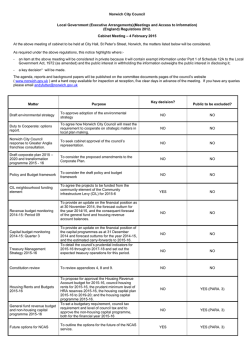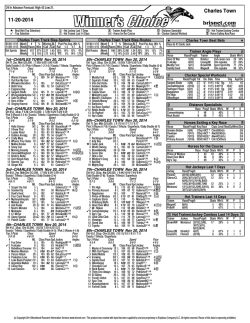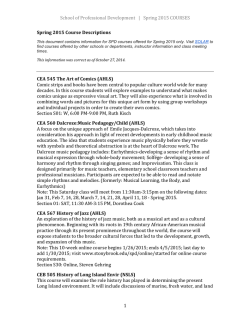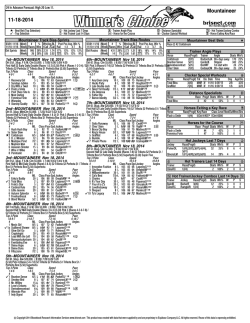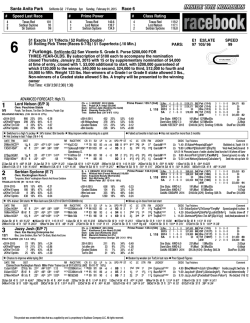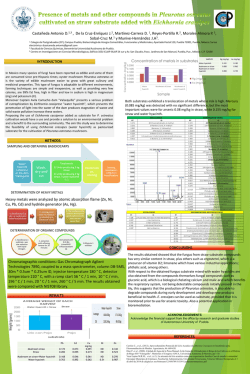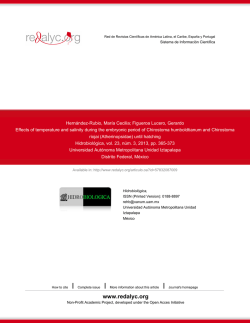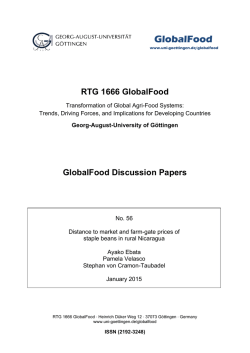
Pre-treatment with spermidine reverses inhibitory effects of salt
Available online www.jocpr.com Journal of Chemical and Pharmaceutical Research, 2015, 7(1):504-509 Research Article ISSN : 0975-7384 CODEN(USA) : JCPRC5 Pre-treatment with spermidine reverses inhibitory effects of salt stress in hyacinth bean (Lablab purpureus) Myrene R. D’souza1* and V. R. Devaraj2 1 2 Department of Chemistry, Mount Carmel College, Palace Road, Bangalore, India Department of Biochemistry, Central College, Bangalore University, Bangalore, India _____________________________________________________________________________________________ ABSTRACT The effects of short-term salinity stress and spermidine pre-treatment on polyamine metabolism, mineral composition and growth of Hyacinth bean were investigated. The levels of diaminoputrescine (DAP), putrescine (Put), spermidine (Spd) and spermine (Spm) were evaluated as possible biomarkers for salinity stress. Ten-day old seedlings were subjected to stress at five different concentrations of NaCl (100-500 mM) and pre-treatment with 0.5 mM Spd in the presence of 300 mM NaCl under strictly controlled growth conditions. Salinity stress resulted in significant reduction in growth index, fresh and dry weight and total chlorophyll content of Hyacinth bean, but pretreatment with Spd significantly enhanced these growth parameters. The results also showed that exogenous application of Spd maintained higher values of [K+]/[ Na+] as compared with NaCl-stressed plants. Salt injuries in plants are mostly due to excess Na+ entry. Therefore, a possible survival strategy under saline environments is the effective compartmentalization of excess Na+ by sequestering it in roots and preventing its uptake into shoots. This study showed that exogenous Spd can be applied as short-term pre-treatment prior to introduction of salt stress to help elevate salt tolerance in Hyacinth bean seedlings. Keywords: Hyacinth bean, putrescine, spermidine, spermine _____________________________________________________________________________________________ INTRODUCTION Polyamines, mainly putrescine (Put, a diamine), spermidine (Spd, a triamine) and spermine (Spm, a tetramine), are polycationic compounds of low molecular weight which accumulate under a variety of abiotic stress conditions [1]. They are regarded as plant growth regulators involved in a broad spectrum of physiological processes, such as embryogenesis, cell division, morphogenesis, vascular differentiation, root initiation, shoot formation, flower initiation and development, fruit ripening, senescence and embryoid formation in tissue cultures [2], [3]. Many of these functions are similar to those mediated by known plant hormones such as auxins, cytokinins, gibberellins, abscisic acid, and ethylene. They also play an integral part in plant stress response either in free or conjugated form [4]. However, the physiological role of stress-induced polyamine accumulation remains unknown. Polyamines titers, altered under abiotic stress, are dependent on several factors, such as plant species, tolerance or sensitivity to stress and duration of stress. The exogenous application of polyamines to the hydroponic media leads to injury alleviation and growth promotion in most cases; although the effects vary between the types of polyamine supplemented and the plant species studied [5], [6], [7], [8]. Salinity-induced increase in endogenous polyamine levels has been reported in various plants [9], [10], [11]. An increase in polyamine levels are known to protect the plant from salinity by scavenging free radicals, stabilizing membrane and cellular structures, maintaining a cation-anion balance [5], modulating ion-channels [12] and stimulation of ATP synthesis [13]. Breeding programs followed make use of transgenic approaches and exogenous polyamine application. The latter has been shown to be a convenient and effective approach for enhancing salinity tolerance of plants [9], [14]. There has been a recent switch to alternative approaches for the improvement of plant 504 Myrene R. D’souza and V. R. Devaraj J. Chem. Pharm. Res., 2015, 7(1):504-509 ______________________________________________________________________________ tolerance to salinity through chemical treatments (plant hormones, minerals, compatible solutes, vitamins and polyamines) and bio-fertilizers [15]. Seed priming with Spd has been found effective to improve the germination and early seedling growth in sunflower [16] and rice [17]. Exogenous Spd also helped to maintain antioxidant enzyme activities of Welsh onion which are able to moderate the radical scavenging system and lessen the oxidative stress [14]. Application of exogenous Spd and Spm to salt stressed rice seedlings showed considerably reduction in the electrolyte leakage, amino acid and chlorophyll loss, and inhibition of photochemical reactions of photosynthesis, as well as the down-regulation of chloroplast-encoded genes like psbA, psbB, psbE and rbcL [9]. This behaviour was attributed to Spd-mediated phosphorylation and activation of 42 kDa Ca2+ -independent nonMAPK protein kinase [18]. In another similar experiment, the application of 1 mM Spd to rice seedlings helped the plant to withstand the negative effect of NaCl [19] due to membrane stabilization, scavenging free radicals and maintaining K+/Na+ balance by Spd. The protective effect of exogenous polyamines under high salinity is associated mainly with improving of the K+/Na+ homeostasis through restricting the Na+ in flux into roots and thus preventing the loss of K+ from cells [20]. Moreover, overexpression of Spd synthase gene in transgenic Arabidopsis thaliana maintained higher levels of Spd content and enhanced tolerance to chilling, salinity, hyperosmosis and drought relative to the wild-type plants, which strongly suggests that Spd plays an important role as a signaling regulator in stress signaling pathways, leading to build-up of stress tolerance mechanisms in plants under stress conditions. These studies further highlight the importance of Spd for stress tolerance in plants. To our knowledge, little evidence exists on the effect of exogenous Spd application on the ability of roots to exclude transport of Na+ to the aerial tissues of Hyacinth bean grown under saline conditions. In order to understand salinityinduced changes in the titers of polyamines and to achieve a possible correlation between the levels of polyamines and the degree of salt tolerance in Hyacinth bean, the present study was undertaken. EXPERIMENTAL SECTION Plant material and treatments The seeds of Dolichos lablab (cv HA-4) were procured from National Seed Project, University of Agricultural Science, Bengaluru, India. They were surface sterilized with 0.1% (w/v) mercuric chloride for 30 s, rinsed immediately with large volume of sterile distilled water and imbibed overnight in distilled water. The overnightsoaked seeds were sown in trays containing vermiculite and acid-washed sand (1:1 w/w) and irrigated daily for ten days with distilled water. The germination was carried out under natural greenhouse conditions; day/night temperature and relative humidity were: 30/25 °C and 75/70 % respectively. The average photoperiod was 12 h light/12 h dark. Salinity stress application and experimental design Ten days old seedlings of uniform size were treated as follows; (1) For salt stress, seedlings were fed with halfstrength Hoagland medium [21] containing 100 - 500 mM NaCl. (2) For studies involving exogenous Spd; two treatment groups were pre-treated with 0.5 mM Spd in Hoagland media. After 24 h of Spd pre-treatment, plants of one treatment group (Spd) were transferred to normal nutrient solution whereas those of the other to nutrient solution containing 300 mM NaCl (NaCl+Spd). (3) One set of plants cultured in Hoagland media throughout the experiment served as the control (C). After 5 days of salt treatment, plants were collected for determination of growth and physiological changes. The experiment was arranged in a completely randomized design with five replicates. Determination of Growth indices Ten plants were randomly selected from the containers to determine the growth index (% G), fresh and dry weight. Plant dry weight was determined by drying in a 65 °C hot air oven until the weight became constant. Total Chlorophyll The procedure of chlorophyll determination was based on the work of Mackinney [22] on the absorption of light by aqueous acetone (80%) extracts of chlorophyll with at 663 and 645 nm. The concentrations of total chlorophyll were calculated by the formula [23] as given below: Total Chl = [(20.2 × A645) + (8.02 × A663)] × (V / 1000 × wt) Determination of metal content Shoots and roots of the sample plants were oven-dried at 70 ºC to constant weight. The dry samples were ground into a fine powder and assayed for minerals using the wet digestion method [24]. The ion contents (Na+, K+) were assayed using an atomic absorption flame photometer (AA-6601 F; Shimadzu Corporation, Tokyo). 505 Myrene R. D’souza and V. R. Devaraj J. Chem. Pharm. Res., 2015, 7(1):504-509 ______________________________________________________________________________ Polyamine analysis Total free polyamine levels were determined in leaves and roots of Field bean [25] with slight modification. Each 100 mg of tissue was homogenized with 1.0 ml 5% (w/v) cold perchloric acid using a cooled mortar and pestle. The homogenates were kept in an ice bath for 1 h, and then centrifuged at 15,000g for 30 min at 4 °C; the supernatant was transferred to new plastic vials and were stored at -70°C for PA quantification. Plant extracts were benzoylated. 1.0 ml of 2 M NaOH was mixed with 500 µl supernatant. After the addition of 10 µl benzoyl chloride, samples were vortexed for 20 s, incubated for 20 min at 37 °C. Following the high temperature incubation, 2 ml of saturated NaCl was added. Benzoyl-polyamines were extracted in 2 ml diethyl ether and vortexed for 10 s. After centrifugation at 12,000 g for 5 min at 4°C, 1 ml of the ether phase was collected, evaporated to dryness under a stream of warm air, and redissolved in 100 µl methanol. The benzoylated extracts were filtered through a 0.22 µm membrane filter, and then separated by HPLC (Shimadzu) on a reverse-phase C18 column (Alex-Octadecysilane), 5 particle diameter, 4.6 × 250 mm using methanol:water (64:36) at a flow rate of 1ml/min. Eluted peaks were detected by a spectrophotometer (Shimadzu, UV 254 nm) recorded and integrated by an attached computer. Standards (Put, Spd, Spm and DAP) and plant extracts were determined with the same method. RESULTS AND DISCUSSION Endogenous polyamine levels The effect of salt stress (100 – 500 mM) on the endogenous levels of DAP, Put, Spd and Spm was studied in root and leaf tissues of Hyacinth bean seedlings subjected to NaCl stress for 72 h. Plants stressed with NaCl exhibited time- and concentration-dependent decrease in Put and an increase in DAP levels in both leaf and root tissue (Fig. 1). However, Spd was found to increase, while Spm decreased in leaf tissue. The opposite behavior in Spd and Spm levels was noted in the root tissue (Fig. 1). This differential accumulation of polyamines in the two tissues indicated that individual polyamines may have diverse roles in diminishing the injurious effects of salinity stress. Similar results were reported in NaCl stressed apple [26] and barley [14]. Excessive accumulation of Put is toxic to plant growth and is considered a negative factor to salt tolerance [27], [14]. Thus, alleviation of salt injury and detoxification could be achieved by increasing the conversion of Put to Spd [6]. Consequently, it has been reported that salinity significantly enhanced the augmentation of Spm and Spd accompanied with a reduction in Put in wheat cultivars [28]. Also, the increase in DAP levels upon stress could be explained by the fact that Spd is oxidized to signaling molecules, H2O2 and DAP [29]. Correspondingly, Spd synthesis in the salt-tolerant variety is stimulated to stabilize membrane systems. Similar to our results, salt tolerance in sun flower plants was related to the excessive augmentation of Spm in root tissues of salt tolerant cultivar Coban under saline condition [26]. Similarly, only Spm content was found to increase in roots of Pringlea antiscorbutica seedlings subjected to long term exposure to 300 mM NaCl [30]. Higher Spm content in roots was shown to be a developmental response to stress and its accumulation in roots facilitated re-initiation of root growth [30]. Thus, the major effect of saline stress tolerance was the modification of polyamine distribution between roots and shoots. Fig. 1: Levels of DAP, Put, Spd and Spm in leaves (a, b, c, d) and roots (e, f, g, h) of Hyacinth bean seedlings plotted against NaCl concentration Data are mean ± SE of duplicates of three separate replicates, mean values were compared by one way ANOVA (P≤ 0.05) Effect of Spd pre-treatment on endogenous polyamine levels Exogenously applied polyamines have been shown to be beneficial in sustaining growth and reducing deleterious effects of salt stress in several plants including mulberry [31], bean [14] and canola [32]. Application of Spd was found to increase the levels of all polyamines in both leaf and root tissue (Fig. 2). 506 Myrene R. D’souza and V. R. Devaraj J. Chem. Pharm. Res., 2015, 7(1):504-509 ______________________________________________________________________________ Fig. 2: Levels of DAP, Put, Spd and Spm in leaves (a) and roots (b) of Hyacinth bean seedlings pre-treated with Spd Data are mean ± SE of duplicates of three separate replicates, mean values were compared by one way ANOVA (P≤ 0.05). Effect of Spd pre-treatment on growth and mineral composition Saline soils are not found to favor good germination of seeds. Germination of seeds of Field bean was significantly affected by NaCl stress even when followed by re-watering [33]. Monovalent ions such as Na+ are also known to substantially reduce membrane associated Ca2+ causing the immediate increase of K+ efflux across the plasma membrane [34]. Under high external Na+ concentration, Na+ can inhibit K+ uptake and enter the cell through potassium channels. K+ discrimination over Na+ is essential for acquisition of salt tolerance [35]. Salinity stress resulted in large and significant increase in Na+ concentration in the leaf tissue and Spd application led to a significant decrease (Fig. 3a). On the contrary, salinity caused a drastic reduction in K+ but exogenous Spd treatment reduced K+ concentrations only negligibly (Fig. 3b). Corresponding to the changes in Na+ and K+ contents, the ratio of [K+]/[Na+] was considerably decreased by salt stress (i.e., from 5.2 to 2.4). Spd pre-treatment led to a slight increase in [K+]/[Na+] (Fig. 3c). In the absence of NaCl stress, Spd did not have any impact on K+-Na+ homeostasis of Hyacinth bean. The protective effect of polyamines is associated mainly with improving K+/Na+ homeostasis through restricting the Na+ influx into roots and thus preventing the loss of K+ from cells [36]. Furthermore, exogenous Spd inhibits Na+ transport from roots to shoots under conditions of high salinity by reinforcing the barrier effects of Casparian bands, which are beneficial for attenuating the salt injuries in barley seedlings [36]. Salinity stress is known to severely inhibit the H+-ATPase activity in rice plants, but Spd treatment recovered its activity in a multifaceted way [37]. Therefore, it appeared that exogenous Spd help relieve plants from damaging effects of salt stress by reversing inhibitory effects on several crucial biochemical and physiological mechanisms contributing to salt tolerance. Fig. 3:Effects of Spd pre-treatment on Na+ (a) and K+ (b) concentrations and K+/Na+ ratio (c) in leaves of Hyacinth bean seedlings subjected to 300 mM NaCl treatment for 5 days Data are mean ± SE of duplicates of three separate replicates, mean values were compared by one way ANOVA (P≤ 0.05). While leaves of the control plants remained green and healthy, those of stressed plants showed symptoms of leaf rolling, chlorosis and drying near the tips. Salt-stressed symptoms were somewhat alleviated by Spd. Plant fresh and dry weight significantly decreased as a result of salinity (Fig. 4 a,b). The percentage reduction in fresh weight was 49% and the reduction in dry weight was 45.2%. When comparing fresh and dry weight of NaCl-stressed plants with NaCl + Spd-stressed plants, it was found that Spd resulted in lesser reduction in plant fresh weight i.e., 20.4% and an enhancement in dry weight i.e., 2.3%. Loss of chlorophyll due to NaCl stress was 43.6% while NaCl + Spdstressed plants suffered a loss of 18.1% (Fig. 4d). These physiological changes in the presence of NaCl were correlated with overall growth reduction while exogenous Spd effectively alleviated those adverse physiological effects and resulted in some growth improvement (Fig 4c). Salt-induced loss of chlorophyll was accompanied by inhibition of photochemical reactions and down-regulation of chloroplast-encoded genes, all of these inhibitory effects could be reversed by exogenous Spd and Spm [9]. The absorption of exogenous Spd from the growth 507 Myrene R. D’souza and V. R. Devaraj J. Chem. Pharm. Res., 2015, 7(1):504-509 ______________________________________________________________________________ medium and distribution to leaves resulting in an increased amount of total chlorophyll was reported [38]. The evidence that PAs were absorbed, metabolized and bound with photosynthetic proteins in chloroplasts suggested its promising role in stabilizing oligomeric photosynthetic proteins particularly the chl a/b binding proteins from protease action during stress [39]. Extensive literature on the protective roles of exogenous polyamines (Spd and Spm) in maintaining chlorophyll [9], [40], and improving growth parameters in Brassica juncea [11] and Cucumis sativa [41] are available. Fig. 4: Effects of exogenous Spd on fresh weight (a), dry weight (b), growth index (c) and total chlorophyll content (d) of Hyacinth bean seedlings stressed with 300 mM NaCl for 5 days Data are mean ± SE of duplicates of three separate replicates, mean values were compared by one way ANOVA (P≤ 0.05). CONCLUSION Salt stress caused a significant growth reduction. Addition of exogenous Spd to the medium confers better tolerance to salt stress. Salt-induced damages including chlorophyll loss, Na+ accumulation and reduction in K+ were all relieved in Spd treated plants resulting in improved growth performance. Although, beneficial effects of exogenous Spd on the mitigation of the adverse effects of salt stress on physiological processes leading to enhanced tolerance and better growth performance have been well-documented, the mechanisms of action of Spd, at the molecular levels are not yet fully understood. Further studies using modern biological disciplines like electrophysiology, microarray, transcriptomics, proteomics and metabolomics will be helpful to improve our understanding of the involvement of polyamines in biotic and abiotic stress tolerance. Nonetheless, the use of exogenously applied polyamines to improve salt tolerance of Hyacinth bean is a simple and an interesting alternative. Acknowledgement Myrene R. D’souza acknowledges the Council for Scientific and Industrial Research (CSIR), New Delhi, India for SRF. REFERENCES [1] R Krishnamurthy; KA Bhagwat. Plant Physiology, 1989, 91, 500-504. [2] JH Liu; K Nada; C Honda, H Kitashiba; XP Wen; XM Pang; T Moriguchi. J. Exp. Bot., 2006, 57, 2589-2599. [3] G Tonon; C Kevers; O Faivre-Rampant; M Graziani, T Gaspar. J. Plant Physiol., 2004, 161, 701–708. [4] R Alcázar; F Marco; JC Cuevas; M Patron; A Ferrando; P Carrasco; AF Tiburcio; T Altabella. Biotechnol. Lett., 2006, 28, 1867-1876. [5] A Bouchereau; A Aziz; F Larher; J Martin-Tanguy. Plant Sci. Rev., 1999, 140, 103-125. [6] T Capell; L Bassie; P Christou P. Proceedings of National Academy of Sciences, 2004, 101, 9909-9914. [7] G Demetriou; C Neonaki; E Navakoudis; K Kotzabasis. Biochim. Biophys. Acta, 2007, 1767, 272–280. [8] S Sheokand; A Kumari; V Sawhney. Physiol. Mol. Biol. Plant, 2008, 14, 355–362. [9] MK Chattopadhayay; BS Tiwari; G Chattopadhayay; A Bose; DN Sengupta; B Ghosh. Physiol. Plant, 2002, 116, 192–199. [10] M Iqbal; M Ashraf. Environ. Exp. Bot. 2013, 86, 76-85. [11] KK Upreti; GSR Murti. Biol. Plant., 2010, 54, 730–734. [12] AN Lopatin; EN Makhina; CG Nichols. Nature, 1994, 372, 366–369. [13] NE Ioannidis; L Sfichi; K Kotzabasis. Biochim. Biophys. Acta., 2006, 1757(7), 821-828. [14] FG Zhao; S Cheng; YL Liu; WH Zhang. Acta Botanica Sinica, 2003, 45(3), 295-300. [15] MA Hamdia; MAK Shaddad. J. Stress Physiol. Biochem., 2010, 6, 64-90. [16] M Farooq; SMA Basra; M Hussain; H Rehman; BA Saleem. Int. J. Agric. Biol., 2007, 9, 868–872. [17] M Farooq; SMA Basra; H Rehman; M Hussain. J. New Seeds, 2008, 9, 145–155. [18] K Gupta; B Gupta; B Ghosh B; DN Sengupta. Acta Physiol. Plant, 2012, 34, 29–40. [19] P Saleethong; J Sanitchon; K Knogngern, P Theerakulpisut. Asian J. Plant Sci., 2011, 10, 245–254. [20] FG Zhao; P Qin. Plant Growth Regul., 2004, 42, 97–103. 508 Myrene R. D’souza and V. R. Devaraj J. Chem. Pharm. Res., 2015, 7(1):504-509 ______________________________________________________________________________ [21] MM Allen. J Phycol., 1968, 4, 1-4. [22] G Mackinney. J. Biol. Chem., 1941, 140, 315-322. [23] DL Arnon. Plant Physiol., 1949, 24, 1–15. [24] EC Humphries. Modern Methods of Plant Analysis, Vol. 1, Berlin: Springer Verlag, 1956; 468–502. [25] HE Flores. AW Galston. Plant Physiol., 1982, 69, 701-706. [26] F Mutlu; S Bozcuk. Pak. J. Bot., 2007, 39, 1097–1102. [27] W Richard; C Alexandra. Plant Physiol., 1997, 113, 241-248. [28] F El-Shintinawy. Photosynthetica, 2000, 38, 615–620. [29] T Kusano; K Yamaguchi; T Berberich; Y Takahashi. J. Plant Res., 2007, 120, 345-350. [30] I Hummel; F Quemmerais; G Gouesbet; A El Amrani; Y Frenot; F Hennion; I Couée. New Phytol., 2004, 162,705–715. [31] C Das; T Sengupta; S Chattopadhyay; M Setua; NK Das; B Saratchandra. Acta Physiol. Plant, 2002, 24, 53-57. [32] MT Sakr; AA Arafa. Pak. J. Biol. Sci., 2009, 12, 582-588. [33] RD Myrene; VR Devaraj. Acta Physiologiae Plantarum, 2010, 32(2), 341-353. [34] GR Cramer; A Läuchli; VS Polito. Plant Physiol., 1985, 79, 207-211. [35] MJ Gomez; K Luyten; J Ramos. FEMS Microbiol Lett., 1996, 135, 157-160. [36] F Zhao; CP Song; J He J; H Zhu. Plant Physiol., 2007, 145, 1061–1072. [37] P Roy; K Niyogi; DNS Gupta; B Ghosh. Plant Sci., 2005, 168, 583–591. [38] AM Tassoni; V Buuren; M Franceschetti; S Fornale; N Bagni. Plant Physiol. Biochem., 2000, 38, 383-393. [39] DS Duca; S Beninati; D Serafini-Fracassini. Biochem. J., 1995, 305, 233-237. [40] A Roychoudhury; S Basu; DN Sengupta. J. Plant Physiol. 2011, 168, 317-328. [41] J Duan; J Li; S Guo; Y Kang. J. Plant Physiol., 2008, 165, 1620-1635. 509
© Copyright 2025
